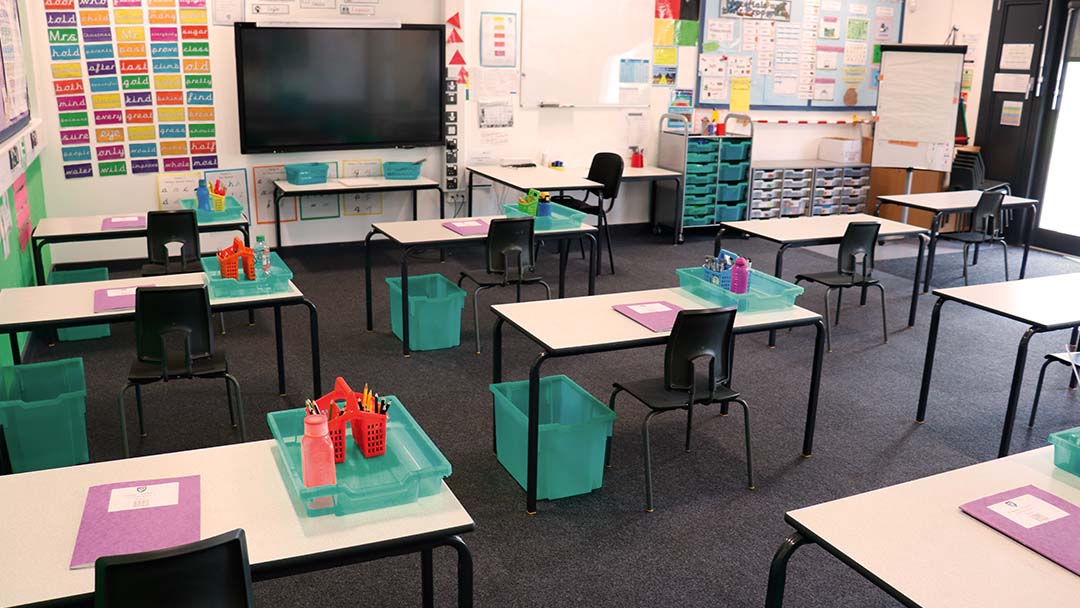There’s an extra plate for teachers to spin now. Socially distanced classrooms are definitely a challenge, but teachers are some of the best problem solvers on the planet. You got this. And we got you with these tips for social distancing within the classroom. Read through our ideas for prepping your classroom for a full return.
1. Socially distant classroom desk arrangements
You probably have a preferred desk arrangement but ensuring social distancing in your classroom is going to change things up, at least for a while. Meaning no group tables and you can say goodbye to the ‘L shape’. The optimum arrangement for desks in order to ensure children are socially distanced whilst sat at their desks depends hugely on the size and shape of your classroom.
The arrangement that takes up the least amount of space is rows of desks, carefully distanced in both directions.
However, if you have a little more space, you might like to try out a horseshoe or double horseshoe. This arrangement helps hugely with group discussion and still enables distance between desks.
The final option and the one that needs the most space is the stadium option. Whip your tables semi-circles facing towards the front, like a stadium. This layout is great for class discussion, plus it’s a bit more relaxed.
2. Mark the floor for where desks belong
Imagine this: the children have left the classroom and you spend the next few minutes straightening up desks and pulling them back into straight lines. Sound familiar? Mark out on the floor using tape where each desk should be. Now more than ever it’s important that desks don’t creep further and further back. Marking out on the floor where their desk belongs will help pupils correct any sliding desks, saving you from having to measure specific distances between desks every evening. Just stick down some electrical tape for the four corners of the desk, perhaps using different colours for easy identification of bubbles.
3. Give everything a home
It’s important to keep all children’s belongings separate and safe. That can be done easily by providing each child a container to keep their bag and belongings in under their individual desk. Gratnells Antimicrobial Jumbo Tray is perfect for this. Not only are they hardy, they also help to prevent the spread of viruses such as SARs.
You might also want to provide children with a tray for their stationery and books that can sit on their desk. Gratnells to the rescue again! Gratnells Shallow Antimicrobial Tray is big enough for a pencil case, reading books and exercise books. This arrangement has the added bonus of helping children be more organised and independent about looking after equipment.
4. Lay out class expectations
It’s common to start the new school year laying down the law. But this year, some new ground rules are going to have to be laid out. Obviously, take influence from your school and their policies but make it clear in your own mind what will work for your classroom and make it fun!
What’s your classroom greeting going to be? Will there be different greetings for different bubbles? This is a great way to create excitement and exclusivity around something that could be seen as different and a bit scary. We can’t hug anymore, but we can air hug or elbow bump.
5. Re-think classroom jobs
Giving children jobs to do in the classroom is beneficial in so many ways and a socially distanced classroom doesn’t mean it can’t continue. It does mean children given jobs that involve handing out or tidying will need to make sure they wash their hands on the regular. You might want to think about assigning jobs within a single bubble. Do you need two book handlers? Do you usually have two librarians? They might need to be from the same bubble.
You don’t have to get rid of classroom jobs, they just might involve more thought and planning.
6. Get that hand-washing routine shipshape
Pupils shouldn’t be shocked at the amount of hand washing now required, but they might need a gentle reminder every now and again. Encourage children to help to remind each other – and you! We can all be forgetful. Lay out the expectations early and kick start that routine straight away.
7. Colour code where you can
You can colour code anything with a bit of coloured tape. Organise the classroom so that bubbles of children are clear about which resources are for them and which ones they shouldn’t be touching.
You can even colour code carpet time! If you have a small group joining you on the carpet, taped crosses can clearly indicate where children are allowed to sit, or you could even invest in a Rainbow Semi-circle Carpet rug that does the same job and injects some serious colour into the classroom.
8. Take the classroom outdoors
If you’re feeling a little restricted by the classroom, there has never been a better time to take learning outdoors. Ventilation reduces the transmission of COVID according to experts and the outdoors presents huge opportunity in all different subjects. Lay out your expectations for behaviour outdoors and ensure children understand social distancing is still important and away you go. If you’re looking for ideas for taking your lessons outdoors, take a look at our ideas for taking maths outdoors.

